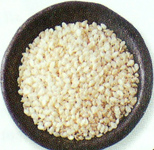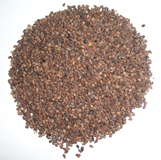Sesame seeds nutrition facts
One of the first oil seeds known to humankind, sesame seeds are used in culinary as well as in traditional medicines for their nutritive, preventive, and curative properties. Its oil seeds are sources for some phyto-nutrients such as omega-6 fatty acids, flavonoid phenolic anti-oxidants, vitamins and dietary fiber with potent anti-cancer as well as health promoting properties.
Sesame plant is a tall annual herb of the Pedaliaceae family, which grows extensively in Asia, particularly in Burma, China, and India. It is also one of the chief commercial crops in Nigeria, Sudan and Ethiopia. Its scientific name: Sesamum indicum.
 |  |
| White sesame in a bowl. | Brown and black sesame seeds. |
The plant requires well-drained sandy soil and tropical environment to flourish. It grows to about 5 feet tall and bears plenty of pink-white foxglove type flowers. The pods appear soon containing white, brown, or black seeds depending up on the cultivar type, arranged in rows inside. Each pod (2-5 cm in length) is a long rectangular box like capsule with deep grooves on its sides. A single pod (1 to 3 inches in length) may contain up to 100 or more seeds.
Sesame seeds are small, almost oblate in shape featuring pleasant nutty flavor and high oil content.
Health benefits of sesame seeds
- Delicious, crunchy sesame seeds are widely considered healthful foods. 100 g of seeds provide 573 calories. Although, much of its calorie comes from fats, sesame contains several notable health-benefiting nutrients, minerals, antioxidants and vitamins that are essential for wellness.
- The seeds are especially rich in mono-unsaturated fatty acid oleic acid, which comprise up to 50% fatty acids in them. Oleic acid helps to lower LDL or "bad cholesterol" and increases HDL or "good cholesterol" in the blood. Research studies suggest that Mediterranean diet which is rich in mono-unsaturated fats help to prevent coronary artery disease and stroke by favoring healthy lipid profile.
- The seeds are an also very valuable source of dietary proteins with fine quality amino acids that are essential for growth, especially in children. Just 100 g of seeds provide about 18 g of protein (32% of daily-recommended values).
- In addition, sesame seeds contain health benefiting compounds such as sesamol (3, 4-methylene-dioxyphenol), sesaminol, furyl-methanthiol, guajacol (2-methoxyphenol), phenylethanthiol and furaneol, vinylguacol and decadienal. Sesamol and sesaminol are phenolic anti-oxidants. Together, these compounds help stave off harmful free radicals from the human body.
- Sesame is among the seeds rich in quality vitamins and minerals. They are very good sources of B-complex vitamins such as niacin, folic acid, thiamin (vitamin B1), pyridoxine (vitamin B6), and riboflavin.
- 100 g of sesame contains 97 µg of folic acid, about 25% of recommended daily intake. Folic acid is essential for DNA synthesis. When given to expectant mothers during the peri-conception period, it may prevent neural tube defects in the baby.
- Niacin is another B-complex vitamin found abundantly in sesame. About 4.5 mg or 28% of daily-required levels of niacin is provided by just 100 g of seeds. Niacin helps reduce LDL-cholesterol levels in the blood. In addition, it enhances GABA activity inside the brain, which in turn helps reduce anxiety and neurosis.
- The seeds are incredibly rich sources of many essential minerals. Calcium, iron, manganese, zinc, magnesium, selenium, and copper are especially concentrated in sesame seeds. Many of these minerals have a vital role in bone mineralization, red blood cell production, enzyme synthesis, hormone production, as well as regulation of cardiac and skeletal muscle activities.
Just a hand full of sesame a day provides enough recommended levels of phenolic anti-oxidants, minerals, vitamins and protein.
See the table below for in depth analysis of nutrients:
Sesame seeds (Sesamum indicum), whole, dried,
Nutritional value per 100 g.
(Source: USDA National Nutrient data base)
| Principle | Nutrient Value | Percentage of RDA |
|---|
| Energy | 573 Kcal | 29% |
| Carbohydrates | 23.45 g | 18% |
| Protein | 17.73 g | 32% |
| Total Fat | 49.67 g | 166% |
| Cholesterol | 0 mg | 0% |
| Dietary Fiber | 11.8 g | 31% |
| Vitamins | | |
|---|
| Folates | 97 µg | 25% |
| Niacin | 4.515 mg | 28% |
| Pantothenic acid | 0.050 mg | 1% |
| Pyridoxine | 0.790 mg | 61% |
| Riboflavin | 0.247 mg | 19% |
| Thiamin | 0.791 mg | 66% |
| Vitamin A | 9 IU | <1 td=""> |
| Vitamin C | 0 | 0% |
| Vitamin E | 0.25 mg | 2% |
| Electrolytes | | |
|---|
| Sodium | 11 mg | 1% |
| Potassium | 468 mg | 10% |
| Minerals | | |
|---|
| Calcium | 975 mg | 98% |
| Copper | 4.082 mg | 453% |
| Iron | 14.55 mg | 182% |
| Magnesium | 351 mg | 88% |
| Manganese | 2.460 mg | 107% |
| Phosphorus | 629 mg | 90% |
| Selenium | 34.4 µg | 62.5% |
| Zinc | 7.75 mg | 70% |
| Phyto-nutrients | | |
|---|
| Carotene-ß | 5 µg | -- |
| Crypto-xanthin-ß | 0 µg | -- |
| Lutein-zeaxanthin | 0 µg | -- |
Selection and storage
Sesames are readily available in the spice stores all around the year. You may choose from whole, husked or air-dried seeds in the stores. There may be black, brown, yellow or white color seeds packed in air-seal packs as well as in bulk bins. Husked seeds appear white.
Sesame contains more of unsaturated fats hence should be stored in airtight containers to avoid them turn rancid. At home, place them in cool dark place. Properly stored dry seeds generally stay fresh for several months. Store hulled "white" seeds always in the refrigerator.
Avoid old, offensive smelling (rancid) seeds.
Culinary uses
Sesame seeds have a delicate nutty flavor. Their flavor indeed becomes more pronounced once they are gently roasted under low flame just for few minutes.
Sesame seeds are used liberally in cooking. The seeds ground with olive or any other vegetable oil to make a semi-solid, flavorful paste, which is then added to different cuisine.
- Dry, roasted sesame seeds and vegetable oil are ground into a thin light brown color paste known astahini. Tahini is one of the main ingredients in famous middle-eastern dip, hummus.
- Dry fried seeds sprinkled over toasts, biscuits, breads, cakes, salads, stir fries etc.
- The seeds are largely used in the manufacture ofmargarine in Europe.
- The seeds are used in many traditional south-Indian sweet delicacies, often mixed with roasted peanuts, almonds, and jaggery.
- Roasted and crushed seeds often sprinkled over salads, desserts, particularly sundaes and other ice cream based preparations.
- Gomashio is a Japan's specialty, which uses ground sesame seeds.
- Sesame oil obtained from the seeds is one of the most sought after cooking oil in Malaysia, Indonesia and southern states of rural India.
Safety profile
Sesame seed allergy is a kind of hypersensitivity reaction in some sensitive individuals. Generally, the reactions include hives, dermatitis and itching. Sometimes the disease manifestation may be severe and may lead to serious physical symptoms like vomiting, pain abdomen, swelling of lips and throat leading to breathing difficulty, chest congestion, and death. It is, therefore, sesame products may be avoided as food in these individuals.
(Medical Disclaimer).

